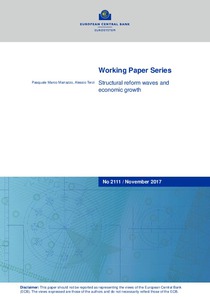Structural reform waves and economic growth
"At a time of slow growth in several advanced and emerging countries, calls for more structural reforms are multiplying. However, estimations of the short- and medium-term impact of these reforms on GDP growth remain methodologically problematic and still highly controversial. We contribute to...
| Main Authors: | , |
|---|---|
| Institution: | ETUI-European Trade Union Institute |
| Format: | TEXT |
| Language: | English |
| Published: |
Frankfurt am Main
2017
ECB |
| Subjects: | |
| Online Access: | https://www.labourline.org/KENTIKA-19396460124911146429-Structural-reform-waves-and-ec.htm |
| Summary: | "At a time of slow growth in several advanced and emerging countries, calls for more structural reforms are multiplying. However, estimations of the short- and medium-term impact of these reforms on GDP growth remain methodologically problematic and still highly controversial. We contribute to this literature by making a novel use of the non-parametric Synthetic Control Method to estimate the impact of 23 wide-reaching structural reform packages (including both real and financial sector measures) rolled out in 22 countries between 1961 and 2000. Our results suggest that, on average, reforms started having a significant positive effect on GDP per capita only after five years. Ten years after the beginning of a reform wave, GDP per capita was roughly 6 percentage points higher than the synthetic counterfactual scenario. However, average point estimates mask a large heterogeneity of outcomes. Benefits tended to materialise earlier, but overall to be more limited, in advanced economies than in emerging markets. These results are confirmed when we use a parametric dynamic panel fixed effect model to control for the rich dynamics of GDP, and are robust to a variety of alternative specifications, placebo and falsification tests, and to different indicators of reform." |
|---|---|
| Physical Description: | 64 p. Digital |

